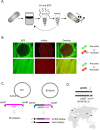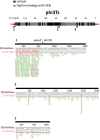Pervasive prophage recombination occurs during evolution of spore-forming Bacilli
- PMID: 33343000
- PMCID: PMC8115142
- DOI: 10.1038/s41396-020-00854-1
Pervasive prophage recombination occurs during evolution of spore-forming Bacilli
Abstract
Phages are the main source of within-species bacterial diversity and drivers of horizontal gene transfer, but we know little about the mechanisms that drive genetic diversity of these mobile genetic elements (MGEs). Recently, we showed that a sporulation selection regime promotes evolutionary changes within SPβ prophage of Bacillus subtilis, leading to direct antagonistic interactions within the population. Herein, we reveal that under a sporulation selection regime, SPβ recombines with low copy number phi3Ts phage DNA present within the B. subtilis population. Recombination results in a new prophage occupying a different integration site, as well as the spontaneous release of virulent phage hybrids. Analysis of Bacillus sp. strains suggests that SPβ and phi3T belong to a distinct cluster of unusually large phages inserted into sporulation-related genes that are equipped with a spore-related genetic arsenal. Comparison of Bacillus sp. genomes indicates that similar diversification of SPβ-like phages takes place in nature. Our work is a stepping stone toward empirical studies on phage evolution, and understanding the eco-evolutionary relationships between bacteria and their phages. By capturing the first steps of new phage evolution, we reveal striking relationship between survival strategy of bacteria and evolution of their phages.
Conflict of interest statement
The authors declare that they have no conflict of interest.
Figures






Similar articles
-
Developmentally-regulated excision of the SPβ prophage reconstitutes a gene required for spore envelope maturation in Bacillus subtilis.PLoS Genet. 2014 Oct 9;10(10):e1004636. doi: 10.1371/journal.pgen.1004636. eCollection 2014 Oct. PLoS Genet. 2014. PMID: 25299644 Free PMC article.
-
New Bacillus subtilis vector, pSSβ, as genetic tool for site-specific integration and excision of cloned DNA, and prophage elimination.J Gen Appl Microbiol. 2022 Sep 15;68(2):71-78. doi: 10.2323/jgam.2021.10.004. Epub 2022 Apr 6. J Gen Appl Microbiol. 2022. PMID: 35387911
-
Mechanism of bacterial gene rearrangement: SprA-catalyzed precise DNA recombination and its directionality control by SprB ensure the gene rearrangement and stable expression of spsM during sporulation in Bacillus subtilis.Nucleic Acids Res. 2017 Jun 20;45(11):6669-6683. doi: 10.1093/nar/gkx466. Nucleic Acids Res. 2017. PMID: 28535266 Free PMC article.
-
Closely related and yet special - how SPβ family phages control lysis-lysogeny decisions.Trends Microbiol. 2025 Apr;33(4):387-396. doi: 10.1016/j.tim.2024.11.007. Epub 2024 Dec 6. Trends Microbiol. 2025. PMID: 39645480 Review.
-
The life cycle of SPβ and related phages.Arch Virol. 2021 Aug;166(8):2119-2130. doi: 10.1007/s00705-021-05116-9. Epub 2021 Jun 7. Arch Virol. 2021. PMID: 34100162 Free PMC article. Review.
Cited by
-
Campylobacter prophage diversity reveals pervasive recombination between prophages from different Campylobacter species.Microbiol Spectr. 2024 Jan 11;12(1):e0279523. doi: 10.1128/spectrum.02795-23. Epub 2023 Dec 13. Microbiol Spectr. 2024. PMID: 38088548 Free PMC article.
-
Disarm The Bacteria: What Temperate Phages Can Do.Curr Issues Mol Biol. 2023 Feb 1;45(2):1149-1167. doi: 10.3390/cimb45020076. Curr Issues Mol Biol. 2023. PMID: 36826021 Free PMC article. Review.
-
synphage: a pipeline for phage genome synteny graphics focused on gene conservation.Bioinform Adv. 2024 Aug 29;4(1):vbae126. doi: 10.1093/bioadv/vbae126. eCollection 2024. Bioinform Adv. 2024. PMID: 39224836 Free PMC article.
-
Lysogenic bacteriophages encoding arsenic resistance determinants promote bacterial community adaptation to arsenic toxicity.ISME J. 2023 Jul;17(7):1104-1115. doi: 10.1038/s41396-023-01425-w. Epub 2023 May 9. ISME J. 2023. PMID: 37161002 Free PMC article.
-
Mutualistic interplay between bacteriophages and bacteria in the human gut.Nat Rev Microbiol. 2022 Dec;20(12):737-749. doi: 10.1038/s41579-022-00755-4. Epub 2022 Jun 30. Nat Rev Microbiol. 2022. PMID: 35773472 Review.
References
-
- Knowles B, Silveira CB, Bailey BA, Barott K, Cantu VA, Cobián-Güemes AG, et al. Lytic to temperate switching of viral communities. Nature. 2016;531:466–70. - PubMed
-
- Azam AH, Tanji Y. Bacteriophage-host arm race: an update on the mechanism of phage resistance in bacteria and revenge of the phage with the perspective for phage therapy. Appl Microbiol Biotechnol. 2019;103:2121–31. - PubMed
-
- Harrison E, Brockhurst MA. Ecological and evolutionary benefits of temperate phage: what does or doesn’t kill you makes you stronger. BioEssays. 2017;39:1700112. - PubMed
Publication types
MeSH terms
Grants and funding
LinkOut - more resources
Full Text Sources
Molecular Biology Databases

